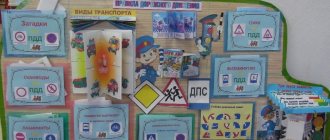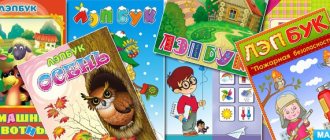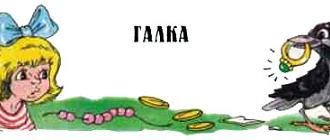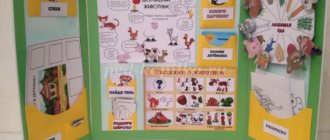A lapbook on the topic “Traffic Rules” will help you clearly and playfully tell children the rules of road safety. You can easily and quickly find here hundreds of useful ideas for creating lapbooks with manuals, cards and games on traffic rules.
Explain to children the rules of the road and the basics of road safety with ready-made MAAM lapbooks!
Below are publications by teachers with photographs of homemade lapbooks on traffic rules and road safety, used in classes with children of preschool and primary school age.
What is a traffic rules lapbook for preschoolers
The concept of lapbook is made up of two English words: lap (lap) + book (book). Such an interactive educational book is needed to collect and organize information on any topic. Each lapbook is individual. Its structure can be arbitrary, depending on the wishes of the child and his level of knowledge on the topic.
The main advantages of such a book for a child:
- Attractive appearance that arouses interest and is an incentive to study the content.
- A large amount of information presented in a concise form that is easy to learn and remember.
Typewriter folder created by preschool students
The traffic rules lapbook for kindergarten is designed to familiarize pupils of different age groups with traffic rules, signs and symbols on the road, illustrate examples of dangerous and safe behavior near the roadway, help the child learn these rules and not get confused on the spot. In a kindergarten, a lapbook can be made in the form of a common stand or folder for each child.
Stages of creating a lapbook with your own hands
Before you make a lapbook with your own hands, you need to decide on the topic and think about what such a teaching aid will include. You can write down the components of a laptop on paper in the form of a plan.
You also need to prepare the following materials and tools:
- cardboard folder as a base;
- white and colored paper;
- scissors;
- glue;
- stapler;
- scotch.
Afterwards, you need to do the following:
| Stage | Description |
| 1 | On a sheet of A4 paper, folded in the form of a laptop, draw a layout of the future manual. Indicate in which place which element will be located:
|
| 2 | Research a topic and find information on it. It is better if there are several sources for this. This will help:
|
| 3 | Prepare elements for a laptop. For example:
|
| 4 | In accordance with the layout, create a life-size laptop folder template |
| 5 | Cut out all the parts and glue them to the pre-designated places |
When working, you must remember:
- security _ All materials must not be hazardous when used. For example, if you use staples, they should be covered on top with a decorative element or a strip of self-adhesive paper;
- reliability _ If you plan to use a laptop for a long time and frequently, it is better to laminate the base with pockets, the pictures can be covered with tape on both sides, and use cardboard or whatman paper instead of plain paper.
The didactic manual “Lapbook on Traffic Rules” is suitable for use by kindergarten teachers, school teachers and parents. It will help organize interesting and effective work for children to learn the rules on the roads.
Lapbook on traffic rules in preschool educational institutions: production
The basis of the reference lapbook is created by the teacher, and the structure and individual elements are created by the child together with parents, teachers from the kindergarten and other children. With the help of a colorful lapbook, a child can easily understand, structure and remember important definitions and rules, and learn previously learned material. The basis of a lapbook can be a cardboard folder for storing documents or a folded sheet of cardboard.
Elements of the internal content of the manual can be printed in the form of templates or made independently. The inside of the folder in the form of 2-3 sheets of A3 or A4 format is covered with colored paper or scrapbooking paper. Pockets, mini-books, notebooks, etc. are glued in any form. It is advisable to place important traffic rules in a separate envelope, and fill other elements of the folder with riddles, puzzles, poems and games.
Additional Information! The cover and title page of the laptop can be decorated with a thematic picture or drawing, or 3D applique. Inside the folder you can stick decorative elements in the form of figures made of felt or paper.
Content
During the creation and filling of a lapbook, the child demonstrates his creative abilities, aesthetic taste, applies theoretical skills acquired in class, groups materials according to certain characteristics, and better understands and remembers information.
Didactic manual with various elements
A lapbook on traffic rules in a preschool educational institution may contain the following:
- cards;
- envelopes (standard, curly) and pockets;
- houses with opening shutters;
- photographs and drawings;
- diagrams and tables;
- small books (with pages and accordions);
- moving elements (rotating circles).
Examples of lapbooks on traffic rules
Before starting to work on a lapbook, you need to outline what the child should learn and master in the process of studying with the book, which elements to place, in what sequence.
For example:
- Rules of conduct for a preschooler on the road and near the roadway;
- road signs and indicators;
- types of vehicles;
- familiarization with the traffic controller's uniform and his tools;
- poems dedicated to traffic rules;
- traffic rules quiz;
- thematic riddles.
Art lesson on the topic “Border guard with a dog” in senior groups of preschool educational institutions
Note! Rules of behavior on the road can be presented in poetic form, easy and exciting for a child.
Draw vehicles on the cards. The child must distribute them into pockets, each containing a specific type of transport (special equipment, land, railway, air, water). The goal is to develop classification skills and introduce new concepts.
To get acquainted with road signs and pointers, the child can be asked to color their images, solve riddles and puzzles. Print the text of the riddle on each card. Also prepare cards with images - answers. Distribute all materials into envelopes. The teacher reads the text of the riddle, and if the child answers correctly, shows a picture.
This activity contributes to the following:
- memory training;
- development of intelligence;
- mastering traffic rules in a playful way.
On one of the sheets you can place a colorful image of a traffic controller with a description of the elements of his uniform and tools (rod and whistle), and give a poem about a representative of this profession. The quiz can be about traffic rules, traffic signals, road signs or markings.
Example of a colorful leaflet
Materials
To make a training knee book you will need the most accessible materials:
- A3 or A4 folder;
- cardboard;
- scrapbooking paper;
- white and colored paper;
- felt;
- paper glue;
- scotch;
- markers;
- watercolor paints and felt-tip pens;
- stapler;
- safety scissors.
Important! During the work, the child must use materials and tools under the supervision of an adult.
Creative materials
For preschoolers
Children under 7 years old are young pedestrians and passengers. Their education should not be approached with the same standards as adults. You can’t just read the text of the traffic rules and think that the children have remembered everything, understood everything and will actively adhere to the described norms.
It is important to understand that both educators and parents should participate in instilling safe street behavior in children. In this case, the desired result can be achieved. The habits that children form at a young age will remain for the rest of their lives.
Important tasks in ensuring safety on city streets are:
- studying traffic rules;
- the formation of a conscious desire to follow them;
- injury prevention.
The best methods for teaching preschoolers traffic rules are various games and exercises. The use of a laptop, a new teaching aid, will be important in such work. It will be useful and interesting for children. An important advantage of this teaching aid is also the fact that its creation is carried out simultaneously by adults and children.
Goals and objectives
A traffic rules lapbook for kindergarten has been used recently. The word is borrowed from English and literally means “knee book.” This translation largely reflects the essence of the manual.
Externally, a lapbook is similar to a book, however, it has many:
- pockets;
- windows;
- doors;
- tabs;
- moving parts.
As a rule, in one lapbook all materials have the same topic, for example, traffic rules.
Lapbook activities help:
- consolidation of a specific topic;
- understanding the content of books;
- conducting research, including searching for information.
The laptop performs 2 main tasks:
- Arouses the child's interest.
- In the form of a game, it provides the necessary information related to a specific topic.
This guide:
- will help the child organize information independently;
- will help you remember it;
- will be a good way to review.
The laptop is recommended for classes in educational institutions, where children of different age categories are collected in one group. The teacher will be able to choose a suitable task individually for each person.
For example, very young children can use card pockets or small paper cutouts. For older students, tasks that require the ability to recognize letters are suitable.
The formation of a system of knowledge and skills of children on traffic rules through a laptop is carried out by performing the following tasks:
- Acquaintance and consolidation of knowledge about the 3 colors of traffic lights. Children must not only learn what color signals what, but understand their importance.
- Familiarity with traffic rules, street structure and road signs.
- Familiarity with the rules of crossing the road, both with and without traffic lights.
- Developing the ability to anticipate danger and avoid it.
- Developing caution, vigilance and independence.
- Stimulation of cognition, development of communication skills.
- Developing safety skills and a sense of self-preservation.
- Fostering a sense of responsibility.
- Development of coherent speech.
Information content
The traffic rules lapbook for kindergarten contains various tasks, each of which lies in a specially designated pocket.
For example:
| Exercise | Description |
| Fun traffic light | Multi-colored circles cut out of paper are used:
Children must learn to understand these traffic lights, and also remember their location relative to each other. |
| Traffic signs | This pocket contains pictures of common road signs, for example, “Pedestrian crossing” |
| Road patches | The material in this pocket should teach children to identify the location of a part of an image in a picture. This contributes to:
|
| Domino | The essence of the game is to select paired pictures. In this game, preschoolers can compete with each other. If the required picture is missing, the turn goes to the next player |
| Puzzles | Children will be interested in solving riddles related to the rules of DD. This contributes to the development of:
|
| What kind of transport is there? | The material from this pocket introduces children to existing types of vehicles and makes them understand how important each of them is to people. |
| Composition of geometric shapes | From the simplest geometric shapes, cut from sheets of paper of different colors, you can create images of objects. For example, a passenger car from:
Afterwards, you need to analyze the resulting image |
| Coloring pages | This pocket contains pictures that have black outlines, and children must color them. All of them are related to traffic rules. It could be:
|
| Discs with cartoons | The plots must be related to traffic rules. For example, this could be several episodes of “Smeshariki” |
A selection of rules
The rules themselves are best taken from educational children's books, where they are presented in a form that children can understand.
The thematic manual should include the following rules:
- crossing the road;
- traffic on the side of the road;
- behavior on the bus and other public vehicles;
- behavior near the road.
You should also make sure that there is a block about “road traps”: about the most dangerous situations that arise on the road.
A selection of poems
Children and adults always remember rhymed texts more easily than prose. Therefore, concepts related to cars and traffic rules should be presented in poetic form.
In Russian literature there are many children's poems dedicated to traffic rules. For example:
- S. Mikhalkov has a wonderful poem “Scooter”, which begins with the words: “The guys are pestering their father...”;
- V. Lebedev-Kumach has a poem “Rink” with the initial line: “The lawns with grass disappeared under the snow...”.
A selection of pictures
A traffic rules lapbook for kindergarten should contain many bright and easy-to-remember pictures. Ideally they should be present in every game.
For example, in a pocket:
- with the riddles there should be pictures showing the answers;
- “What types of transport are there?” there should be pictures with types of vehicles.
Unusual traffic rules lapbook for kindergarten
Images can be drawn in a cartoon style or have human features, for example, eyes, mouth, nose. Road signs should also be illustrated, but it is important to try not to distort them.
Decor
At the early stage of creating a lapbook, great attention should be paid to its shape, because the appearance of this manual should attract children.
The following options are suitable:
- a folder with spreads is a universal variety for any topic (there can be 2 spreads if children are under 4 years old, and for older preschoolers they can be 3-4);
- folder-brochure – pages dedicated to blocks 1-2 (tasks, pictures, coloring pages);
- “accordion” is a product whose spreads can be folded like accordion bellows. However, for younger students, using this type is not recommended: they may have problems with the sequence of folding pages;
- silhouette folders (“the little book” can be in the form of a traffic light or a car).
How to use
You can work with a laptop at home or within the walls of a kindergarten. This manual can be used at any stage of familiarization with this topic.
For example, to remember the rules of DD, children can:
- study the material of the text block;
- look at the images;
- think about riddles;
- solve crosswords, puzzles;
- perform applications;
- have a conversation with peers or adults;
- paint;
- play.
Description of lapbooks
The content of the knee books depends on the age and level of training of the student.
For middle groups 4-5 years old
The purpose of the traffic rules lapbook for middle groups of preschool educational institutions is to introduce preschoolers to the rules of the road for pedestrians and drivers, the components of the road, road signs and indicators for all road users.
Important! The manual is designed to arouse the child’s interest in the topic and introduce important rules in a familiar playful way.
In the process of working with a lapbook, the child will train and develop speech, memory, and communication with other team members.
The folder may contain the following sections:
- cards with traffic rules;
- types of transport in pictures;
- poems about traffic rules;
- simple riddles (texts + pictures);
- labyrinths (to build a safe path from home to preschool educational institution);
- coloring cards (road sign, vehicle);
- thematic puzzles from several parts;
- games with elements of physical activity.
It is better to place cards with traffic rules in a pocket, in the central part of the book. The purpose of this section is to consolidate a young child’s knowledge of traffic rules, convey information about the need to be vigilant and careful near a highway, not to get lost and clearly know how and where to cross the roadway. The purpose of riddles on the topic is to develop intelligence, the ability to correlate a text description and an image of an object, and enrich speech.
The essence of the game “labyrinths” is to create a safe route from point A to point B using chips or fingers with the child’s comments. The goal is to develop intelligence, logic, attention, fine motor skills, and speech.
Neurodynamic gymnastics for brain training in children
Note! To make the lesson more effective, you should change the type of activity.
For example, you can arrange a game between two teams: drivers and pedestrians. The teacher or student takes a blank from the envelope - traffic signals and shows one of the images. Depending on the color, the participants in the game walk or stand still. The goal is to develop memory, reaction speed, and coordination of movements.
For older groups 5-6 years old
Note! The goals of creating a kneeling book for children 5-6 years old are to systematize knowledge on the topic, convey the importance of traffic signals, teach how to classify road signs, develop attention, independence, and caution.
Envelopes with tasks and games in accordance with the age of preschool children:
- meaning of traffic lights;
- road signs and their meaning;
- types of transport (classify, find the odd one out);
- puzzles;
- coloring books (consolidating knowledge on the topic, developing fine motor skills, accuracy);
- poems on the topic of traffic rules;
- puzzles and crosswords;
- questions (to determine the correctness/incorrectness of actions on the road);
- puzzles;
- game “situations on the road” (the teacher voices the situation, and the children act it out on a model of the road using toy men or animals);
- left-right (arrange vehicle printouts according to the direction of travel);
- find differences (up to 10 positions);
- outdoor game (children perform certain actions at the traffic light signal);
- visual information (selection of educational videos and cartoons on the topic of traffic rules).
For preparatory groups 6-7 years old
Pupils of preparatory groups can not only improve their knowledge in the field of traffic rules, but also actively participate in the collection and systematization of information.
The purpose of creating a thematic folder is to consolidate acquired knowledge, awareness of the importance of safe behavior on and near the road, readiness to cross the roadway at both regulated and unregulated crossings, teach how to prevent dangerous situations and clearly act when necessary. You can include all of the above elements in the manual, complicating them and diversifying the content.
Important! Thanks to the attractive appearance and thoughtful structure of the lapbook, children can easily and in a relaxed manner expand their knowledge base.
Folder for older children











